Common menu bar links
Institutional links
Diseases & Conditions
Health & Safety
Research & Statistics
Agency Information
Search Box
E-mail this page
Chapter 4
Ambulatory Care Services
J. Denise Power, Elizabeth Badley
Introduction
The majority of arthritis care in Canada occurs in an ambulatory, or outpatient, setting with a primary care physician as the first line of care. These physicians may serve not only as the main providers of arthritis care but also as gatekeepers to other services, such as consultations with specialists and rehabilitation professionals. The role of the primary care physician is particularly significant in rural and remote areas of Canada where access to specialist care is not readily available. Specialists, particularly rheumatologists and orthopedic surgeons, also often play important roles in arthritis treatment.
Examining the patterns of primary and specialist care for arthritis and related conditions is an important step in the process of assessing the impact of arthritis on the Canadian population, and planning and evaluating health services for those affected. Chapter 4 uses physician billing data from April 1998 to March 1999 from seven participating Canadian provinces* to examine rates of consultation with various physician specialties for different types of arthritis. It focuses on the grouping of all arthritis and related conditions in general, and specifically on osteoarthritis and rheumatoid arthritis.
Osteoarthritis, the most common type of arthritis, is estimated to affect 10% to 12% of the adult population.1,2 Rheumatoid arthritis, a serious autoimmune disease that affects up to 1% of the adult population, may involve multiple organ systems. It is also associated with a significant increase in mortality.2 There is a growing body of evidence about the importance of rheumatological care in the management of rheumatoid arthritis.3-8Joint replacement surgery is recognized as a highly cost-effective procedure for the treatment of advanced osteoarthritis and joints destroyed by rheumatoid arthritis.9-11
Physician Billing Data
Most Canadian physicians operate on a fee-for-service basis, requiring them to submit a claim to their provincial health insurance plan for each patient encounter. Each claim provides a diagnostic code specifying the reason for the visit. In most provinces, only one diagnosis per visit is recorded on the physician claim. As a result, if a person sees a physician for more than one reason, some diagnoses are missed. Each province has a classification scheme of diagnoses based on the International Classification of Diseases (ICD). Table 4A-1 in the Methodological Appendix at the end of this chapter lists the diagnoses for arthritis and related conditions included in the data presented. Contributors from each of the participating provinces analyzed physician claims with a diagnosis of arthritis and related conditions.
Physician Visits Among Adults†
In 1998/99, approximately 163 of every 1,000 Canadians aged 15 years and older made at least one visit to a physician for arthritis and related conditions (referred to as the "person-visit rate") (Table 4-1). On average, each of these individuals made 2.3 visits during the year. More women than men consulted a physician about arthritis and related conditions. The total number of arthritis-related visits in Canada was estimated to be 8.8 million. Only a minority of visits were billed to specific types of arthritis, the majority being attributed to "other arthritis and related conditions", which refers mainly to arthritis symptoms such as synovitis and bursitis. Visits for arthritis and related conditions in Ontario and Alberta accounted for 4.8% of all physician visits in these provinces (data not shown).
Approximately 4% of the population made at least one physician visit with a recorded diagnosis of osteoarthritis, representing just under 23% of all arthritis visits. This is significantly less than epidemiological estimates of osteoarthritis, which suggest a prevalence of 10% to12% in the adult population.1,2 Not everyone with osteoarthritis, however, and especially not those with early or mild osteoarthritis, will consult a physician in the course of a year. Additionally, some osteoarthritis visits were likely missed, either because they were coded more generally as "musculoskeletal symptoms" or because the visits may have been coded for other, unrelated conditions.
Slightly less than 1% of the population visited a physician for rheumatoid arthritis, visiting on average about 3 times during the year. These data support epidemiological prevalence estimates.1,2,12 Women visited a physician for rheumatoid arthritis 2.4 times as often as men. Person-visit rates for other selected types of arthritis also agree with epidemiological prevalence estimates.1,2,12
Rates of consultation with physicians for arthritis and related conditions varied by province, ranging from 146 to 207 persons per 1,000 population (Table 4-2). Provincial differences in person-visit rates for arthritis and related conditions were still present after adjusting for differences in the age and sex composition of the provincial populations. This variation may be due, at least in part, to provincial differences in the coding of visit diagnoses.
|
Table 4-1 Visits to all physicians for arthritis and related conditions among adults aged 15 years and over, Canada, 1998/99 |
||||
|
Condition |
Persons Visiting per 1,000 Population |
Sex Ratio |
Estimated Total Number of Visits* |
Average Number of Visits per Person |
|
Arthritis and Related Conditions |
162.7 |
1.3:1 |
8,800,000 |
2.3 |
|
Osteoarthritis |
40.7 |
1.6:1 |
2,000,000 |
2.1 |
|
Rheumatoid Arthritis |
7.4 |
2.4:1 |
540,000 |
3.1 |
|
Connective Tissue Disorders (e.g. lupus) |
1.9 |
3.1:1 |
110,000 |
2.5 |
|
Ankylosing Spondylitis |
1.1 |
1.0:1 |
40,000 |
1.8 |
|
Gout |
5.2 |
0.3:1 |
200,000 |
1.6 |
|
* A Canadian rate was calculated using data from the participating provinces, and visits for non-participating provinces were estimated by applying this rate to the respective 1998 provincial populations. Source: provincial physician billing data (BC, AB, SK, MB, ON, QC, NS) |
||||
|
Table 4-2 Person-visit rates to all physicians for arthritis and related conditions among adults aged 15 years and over, by province*, Canada, 1998/99 |
|||||||
|
Condition |
Persons Visiting per 1,000 Population** |
||||||
|
BC |
AB |
SK |
MB |
ON |
QC |
NS |
|
|
Arthritis and Related Conditions |
162.8 |
167.7 |
170.3 |
207.3 |
145.5 |
152.2 |
181.4 |
|
Osteoarthritis |
32.3 |
35.8 |
30.5 |
36.1 |
53.1 |
29.9 |
36.2 |
|
Rheumatoid Arthritis |
9.1 |
7.5 |
4.9 |
5.5 |
8.7 |
5.1 |
7.4 |
|
Connective Tissue Disorders |
3.0 |
2.0 |
1.6 |
1.9 |
1.8 |
1.5 |
1.9 |
|
Ankylosing Spondylitis |
0.9 |
1.4 |
1.5 |
1.3 |
0.9 |
1.0 |
2.1 |
|
Gout |
5.8 |
6.1 |
8.4 |
7.0 |
5.5 |
3.5 |
6.8 |
|
* Provincial rates may vary because of differences in the coding of visit diagnoses. See Methodological Appendix at end of chapter. ** Age/sex standardized rates in parentheses. Source: provincial physician billing data |
|||||||
Person-visit rates for all arthritis and related conditions, osteoarthritis and rheumatoid arthritis increased with age. In all age groups, rates among women were greater than among men (Figures 4-1, 4-2 and 4-3). These patterns support the findings of epidemiological studies.1,2,12
Figure 4-1 Person-visit rates to all physicians for arthritis and related conditions,by age, Canada, 1998/99

Source: provincial physician billing data (BC, AB, SK, MB, ON, QC, NS)
Figure 4-2 Person-visit rates to all physicians for
osteoarthritis, by age,
Canada, 1998/99
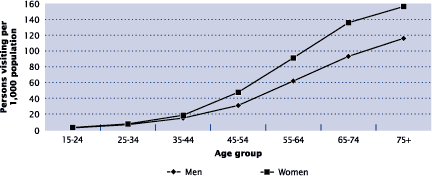
Source: provincial physician billing data (BC, AB, SK, MB, ON, QC, NS)
Figure 4-3 Person-visit rates to all physicians for rheumatoid arthritis, by age, Canada, 1998/99

Source: provincial physician billing data (BC, AB, SK, MB, ON, QC, NS)
Overall, 82% of Canadians who visited a physician for any type of arthritis and related condition in 1998/99 saw a primary care physician at least once (Table 4-3). Nearly 1 in 5 (18.5%) saw a surgical specialist and 13.7% saw a medical specialist at least once. Orthopedic surgeons were the most commonly consulted specialist, particularly for osteoarthritis. A higher proportion of individuals with inflammatory types of arthritis, such as rheumatoid arthritis, connective tissue disorders or ankylosing spondylitis, saw medical specialists compared with the proportion of those consulting for other types of arthritis. In turn, people who saw a physician for rheumatoid arthritis, connective tissue disorders or ankylosing spondylitis were less likely to see primary care physicians. Over one-quarter (26.4%) of patients whose visits were related to rheumatoid arthritis saw a rheumatologist and 17.5% saw an internist at least once.
|
Table 4-3 Distribution of type of physician seen by adults aged 15 years and over for arthritis and related conditions, Canada, 1998/99 |
||||||
|
Condition |
Type of Physician* |
|||||
|
Primary Care |
Surgical Specialists |
Medical Specialists |
||||
|
All |
Orthopedic Surgeons |
All |
Rheumatologists |
Internists |
||
|
Arthritis and Related Conditions |
|
|
|
|
5.5 |
4.8 |
|
Osteoarthritis |
83.8 |
19.1 |
18.1 |
11.8 |
5.5 |
4.8 |
|
Rheumatoid Arthritis |
70.6 |
7.5 |
4.4 |
44.3 |
26.4 |
17.5 |
|
Connective Tissue Disorders |
|
8.0 |
0.7 |
|
|
|
|
Ankylosing Spondylitis |
55.3 |
8.6 |
7.1 |
47.0 |
30.6 |
13.0 |
|
Gout |
97.1 |
1.6 |
0.6 |
9.7 |
4.9 |
3.7 |
|
* Row percentages do not add to 100% because an individual can visit more than one type of physician in a year. Source: provincial physician billing data (BC, AB, SK, MB, ON, QC, NS) |
||||||
The percentage of patients who saw medical and surgical specialists - orthopedic surgeons, rheumatologists and internists - for all arthritis and related conditions, and for osteoarthritis and rheumatoid arthritis specifically, varied by province in 1998/99 (Figures 4-4, 4-5 and 4-6). These differences may in part reflect differences in assignment of physician specialty on claim forms, however, and should be interpreted with caution. Percentages of individuals with arthritis who visited "all medical specialists" and "all surgical specialists" are more likely to be comparable provincially.
Figure 4-4 Percentage of adults aged 15 years and over with arthritis and related conditions who saw surgical and medical specialists, Canada, 1998/99
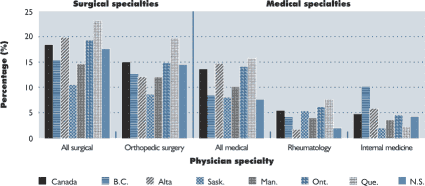
Source: provincial physician billing data
Figure 4-5 Percentage of adults aged 15 years and over with
osteoarthritis who saw surgical and medical specialists, Canada,
1998/99
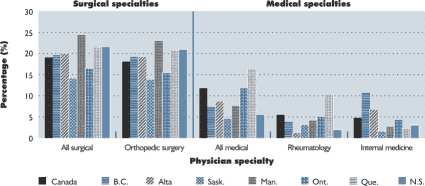
Source: provincial physician billing data
Figure 4-6 Percentage of adults aged 15 years and over with
rheumatoid arthritis who saw surgical and medical specialists,
Canada, 1998/99
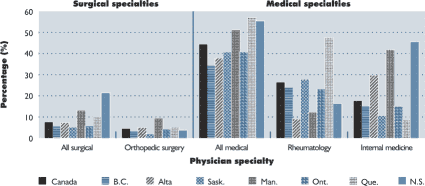
Source: provincial physician billing data
Among participating provinces, Quebec had the highest percentage of individuals who made at least one visit to a physician for arthritis and related conditions and who saw surgical or medical specialists (Figure 4-4). The second highest percentages were in Alberta. In most provinces, there appeared to be a trade-off between seeing a rheumatologist and seeing an internist for arthritis and related conditions, particularly for rheumatoid arthritis (Figure 4-6): provinces with higher percentages of patients who saw a rheumatologist at least once had lower percentages of patients who saw an internist, and vice versa. A number of factors may explain this pattern, including the number of rheumatologists available provincially, their practice locations and the referral patterns of primary care physicians. Once again, the manner in which physician specialty was assigned might have contributed to provincial differences.
In 1998/99, the percentage of patients with an osteoarthritis-related physician visit who saw a surgical specialist at least once was higher for men than women in every age group (Figure 4-7). Percentages increased with age for both sexes and then declined in the oldest age group. A similar pattern was seen among patients with a rheumatoid arthritis-related physician visit who saw a medical specialist at least once (Figure 4-8). The percentages of rheumatoid arthritis patients seeing medical specialists were higher for women than men.
Figure 4-7 Percentage of adults aged 15 years and over with osteoarthritis who saw a surgical specialist, by age, Canada, 1998/99

Source: provincial physician billing data
Figure 4-8 Percentage of adults aged 15 years and over with rheumatoid arthritiswho saw a medical specialist, by age, Canada, 1998/99
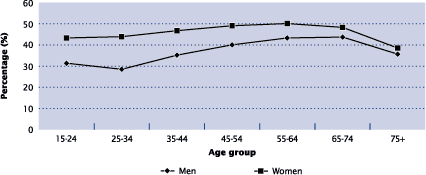
Source: provincial physician billing data
The average number of visits for arthritis and related conditions varied somewhat by type of physician (Figure 4-9): averages were higher for visits to medical specialists than for visits to primary care physicians or surgical specialists. This difference was greater among patients with rheumatoid arthritis than among those with osteoarthritis and reflects the nature of care provided. Medical specialists provide ongoing care for arthritis, particularly for inflammatory types of arthritis like rheumatoid arthritis, and surgical specialists focus on a specific event - surgery.
Figure 4-9 Average number of visits for arthritis and related conditions, osteoarthritis and rheumatoid arthritis by adults aged 15 years and over, by type of physician, Canada, 1998/99

Source: provincial physician billing data (BC, AB, SK, MB, ON, QC, NS)
Discussion
A large number of Canadians (163 in every 1,000 people over the age of 15 years) visited a physician in 1998/99 for arthritis and related conditions. On average, each person made about two visits, for an estimated total of 8.8 million visits for all of Canada. In Ontario and Alberta, arthritis-related visits accounted for 4.8% of all physician visits. More women than men made arthritis-related visits, and older people of both sexes consulted at the highest rates.
Provincially, person-visit rates to all physicians for arthritis and related conditions ranged from 146 to 207 persons per 1,000 population. Provincial differences in person-visit rates were not due solely to differences in the age/sex composition of the provincial populations but may have been due in part to differences in the provinces' physician billing databases. Provincial differences in the availability of physicians, especially specialists, may also contribute to these variations.
Primary care physicians provided the vast majority of care for people in Canada with arthritis and related conditions in 1998/99. Four out of five patients (82%) who sought medical advice because of arthritis and related conditions made at least one visit to a primary care physician. Surgical specialists were most often consulted for osteoarthritis, and individuals with rheumatoid arthritis, connective tissue disorders and ankylosing spondylitis more often sought the help of medical specialists. There appears to be a trade-off provincially between seeing a rheumatologist and seeing an internist for arthritis and related conditions, particularly for rheumatoid arthritis.
Despite the limitations in the data, this chapter presents reasonable agreement with population estimates for arthritis. Provincial self-reported estimates of arthritis and rheumatism range from 12.0% to 23.3% in the CCHS (see Chapter 2). In the data presented here, 15% to 21% of the provincial populations made at least one physician visit for arthritis and related conditions. Further, person-visit rates to all physicians for rheumatoid arthritis agreed with published estimates, as did female-to-male sex ratios for this condition.1,2,12
The information presented in this chapter was based on administrative physician billing data, and this raises issues of validity. Further, because of provincial differences in data collection methods, issues of provincial comparability need to be considered. Refer to the Methodological Appendix at the end of this chapter for a discussion of these issues.
It is unknown to what extent the findings presented in this chapter on specialist care for arthritis and related conditions have been influenced by the availability of specialists. However, to ensure adequate ambulatory care for arthritis and related conditions in Canada, manpower issues should be addressed. Rheumatologists and orthopedic surgeons are the major providers of arthritis specialty care, and shortages of both of these types of specialists are a concern. The Canadian Council of Academic Rheumatologists13 predicts that Canada will require a rheumatology manpower increase of 64% by the year 2026 to meet recently recommended targets for provision. The same organization has also stated that the current rate of recruitment of rheumatologists is insufficient to maintain the current manpower level, let alone meet future needs. The current level of provision of orthopedic services in Ontario is less than half the estimated requirement and a similar, if not greater, shortage likely exists in the other provinces.14
Implications
Arthritis and related conditions place a significant burden on Canada's ambulatory health care system. With the aging of the population, this burden is expected to increase. Current estimates suggest that by 2020 the number of people with arthritis will double.15 Service providers and funding agencies will have to plan carefully to ensure that those affected have access to appropriate primary and specialist care. Manpower issues, such as shortages of both rheumatologists and orthopedic surgeons, are a concern that could be addressed through more recruitment and training of specialists in these fields.
While primary care physicians play a central role in managing arthritis, gaps in musculoskeletal education in undergraduate medical education and postgraduate training have been documented.16-19 When setting curricula, medical educators may wish to draw on information regarding the amount of illness, disability and health care utilization that these conditions cause in the population. For physicians already in practice, continuing education that focuses on hands-on learning may be more effective than traditional continuing education approaches.20
Barriers that limit access to specialty services such as rheumatology need further investigation. In addition to the number of specialists available provincially and their practice locations, the referral patterns of primary care physicians should be further explored. Since a considerable amount of arthritis care is provided by internists (particularly rheumatoid arthritis) and orthopedic surgeons (non-surgical care for osteoarthritis) these specialty groups might wish to consider further training and continuing education with respect to arthritis. Processes and outcomes of care for people treated by these specialists, as compared with rheumatologists, should also be examined.
Strong surveillance efforts depend on both standardized definitions of common terms and their consistent use in different settings. A consensus on definitions would allow coordinated and constant surveillance across Canada. If provinces wish to pursue this matter, they could consider the following:
- Using the same diagnostic codes for billing purposes would be a
major step toward standardizing provincial physician billing data.
Allowing physicians to enter three
diagnostic codes for each claim, as currently practised in Alberta and Nova Scotia, would also provide a more accurate representation of the reasons for each visit. - Physicians' specialties could be determined in the same manner in each provincial health insurance database, and this information actively updated to reflect changes in specialty and sub-specialty training.
- Diagnostic codes in physician claims data need to be validated. Algorithms using specified numbers of visits in a time period for a specific diagnosis need further exploration and validation, building on earlier work for rheumatoid arthritis and diabetes.21
* British Columbia (BC), Alberta (AB), Saskatchewan (SK), Manitoba (MB), Ontario (ON), Quebec (QC), and Nova Scotia (NS)
† For a discussion of data quality issues surrounding the use of physician billing data, see Methodological Appendix at end of chapter.
[Previous][Table of Contents][Next]

